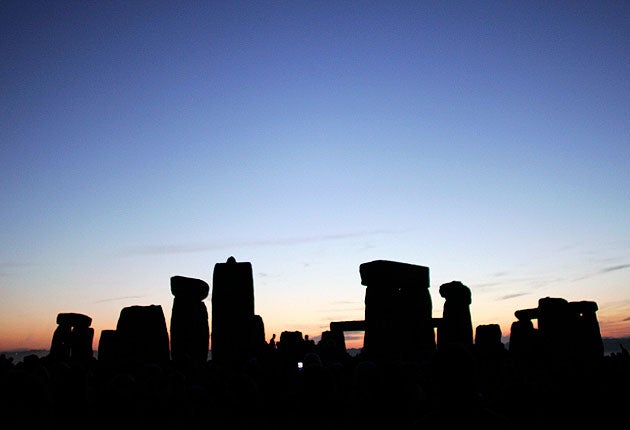Mystery of Stonehenge moves closer to solution

Archaeologists today moved a step closer to solving the mystery of Stonehenge when they disclosed findings to support their theory that it was a prehistoric 'healing centre'.
The findings suggesting its significance to pilgrims came in a historic dig at the World Heritage Site earlier this year.
The first excavation for more than 40 years uncovered fragments of stone which could have been used as lucky charms.
Professors Tim Darvill and Geoffrey Wainwright today gave their preliminary findings of the two-week dig from March 31 to April 13.
They said they could now pinpoint the date at which the blue stones - which the archaeologists believe hold the key to Stonehenge - were brought to the site in Wiltshire from West Wales, as 2,300 BC, which was 300 years later than previously thought.
They also told a press conference at the Society of Antiquaries in London that people remained interested in the magical, healing qualities of the stones for many hundreds of years afterwards.
Prof Darvill, of Bournemouth University said that 60% of the smaller blue stones was broken off, compared with just five to 10% of the large, iconic Sarsen stones.
"Taking those pieces to become talisman, lucky charms, to be used in the healing process is very important," he said.
The professors said Stonehenge could have been a "multifunctional" monument but that the healing motive took on most significance from the time the blue stones were positioned there.
Prof Darvill added: "It could have been a temple at the same time as it was a healing centre, just as Lourdes is still a religious centre."
Prof Darvill suggested the blue stones, a blue stone with white spots that is only found on a crag in the Preseli hills in Pembrokeshire, 156 miles away from Stonehenge, could have acted in a similar way to the bones of saints.
As pilgrims flock to see the relic the resulting wealth enables an "elaborate shell" to be built around it.
In the case of Stonehenge the Sarsen stones were the church building around the magical blue stones, he said.
Prof Wainwright, president of the Society of Antiquaries, said he was inspired to investigate the area in his native Pembrokeshire while watching a television programme about why Stonehenge was built.
He said: "I thought the answer really had to be found in the place where the stones came from. That is in north Pembrokeshire, so Tim and I went and did a survey around the crag.
"We found various reasons which led us to believe the stones were used as part of a belief in a healing process."
But he said they needed to study the Stonehenge site to find out when the bluestones arrived there and how long they were used for.
As well as the bluestone fragments, the excavation, which was the first allowed since 1964, uncovered items including broken bottles from the 19th century and coins and animal bones from the Roman period documenting thousands of years of human activity.
The archaeologists also recovered carbonised plant material, which subsequent radiocarbon analysis dated to 7330-7070BC, showing that people were at the site during that period.
But the radiocarbon dating of the original double bluestone circle held significance for the start of Stonehenge being used as a healing centre, the archaeologists said.
The date - 2300BC - links the introduction of the bluestones with a time of great activity at the site, including the death of the Amesbury archer.
His remains were discovered about five miles from Stonehenge and the professors believe he was a pilgrim hoping to benefit from the healing powers of the monument.
Prof Wainwright said: "We now know, much to our surprise and delight, that Stonehenge was not just a prehistoric monument, it was a Roman and mediaeval monument.
"This is very much a work in progress.
"The scientists are still working on the results, so there are more surprises to come, I am sure of that."
He added: "We are pleased that we are able to say so much more about when Stonehenge was built and why, all of which fundamentally changes our perspective of the monument."
During future excavations of sites around the country, archaeologists will now look for any evidence of bluestone being transported from Wales to other monuments.
They also said they hoped to return to the Preselli Hills next year to excavate part of a burial mound near the main bluestone outcrops.
Prof Darvill said of the bluestones: "Their meaning and importance to prehistoric people was sufficiently powerful to warrant the investment of time, effort and resources to move the bluestones from the Preselli Hills to the Wessex downs."
The Stonehenge excavation involved a hole which measured 11ft 6in (3.5m) wide and 5ft (1.5m) deep.
English Heritage agreed to the dig on Salisbury Plain following consent by the Secretary of State for Culture, Media and Sport.
The project was funded by BBC Timewatch and Smithsonian Networks and a documentary on the findings will be screened on BBC2 at 8pm on Saturday.
Subscribe to Independent Premium to bookmark this article
Want to bookmark your favourite articles and stories to read or reference later? Start your Independent Premium subscription today.

Join our commenting forum
Join thought-provoking conversations, follow other Independent readers and see their replies